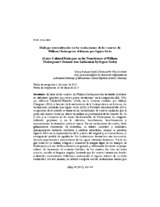Mostrar el registro sencillo del ítem
Diálogos interculturales en las traducciones de los sonetos de William Shakespeare al lituano por Sigitas Geda
| dc.contributor.author | Pabarčienė, Reda | |
| dc.contributor.author | Veličkienė, Deimantė | |
| dc.date.accessioned | 2018-01-31T13:12:49Z | |
| dc.date.available | 2018-01-31T13:12:49Z | |
| dc.date.issued | 2017 | |
| dc.identifier.issn | 2386-9658 | |
| dc.identifier.uri | http://hdl.handle.net/10396/16043 | |
| dc.description.abstract | El ciclo de los sonetos de William Shakespeare fue traducido al lituano en diferentes períodos por cuatro poetas traductores: en la emigración (EE. UU.) por Alfonsas Šešplaukis-Tyruolis (1964), en la Lituania soviética por Aleksys Churginas (1965) y después de la restauración de la Independencia en Lituania, las traducciones realizadas por Sigitas Geda (2009) y Tautvyda Marcinkevičiūtė (2011) se agotaron. Este artículo se centra en las traducciones de sonetos realizadas por el poeta más famoso Geda (se ofrece un análisis en profundidad de los Sonetos 18, 72 y 116) y se concentra en los temas fundamentales de Shakespeare, las imágenes culturales populares y en la selección, transferencia, transformación y representación de elementos poéticos típicos. En sus traducciones de soneto, Geda generalmente conservaba su estructura, su núcleo sintáctico y semántico, principalmente mediante metáforas y antítesis extendidas; aunque se perciben algunos fallos en la representación de la poética del original y, en consecuencia, la consiguiente pérdida de significado. Sus traducciones demuestran una transmisión bastante improvisada e inconsistente de los signos culturales históricos. Puede ser que Geda no se sintiera obligado a conservar la imagen digna de los tiempos de Shakespeare y la era del Renacimiento en general, y obviamente favoreció su propia cultura. Al representar el contexto histórico de los sonetos, los hizo un tanto arcaicos, usando un lenguaje singular; haciendo que los sonetos suenen más locales y dándoles características folklóricas, enfatizando el registro inferior de su estilo contrastivo. De esta manera, no intentó competir con las traducciones hechas por Churginas que dominaron en la época soviética y aún siguen siendo populares en la actualidad, sino que más bien trató de cerrar la brecha entre la cultura 'alta' del Renacimiento Inglés y el 'baja' cultura lituana. | es_ES |
| dc.description.abstract | The whole cycle of William Shakespeare’s sonnets was translated into Lithuanian at different periods by four poet-translators: in emigration (USA) by Alfonsas Šešplaukis-Tyruolis (1964), in Soviet Lithuania by Aleksys Churginas (1965), and after the restoration of Independence in Lithuania, translations done by Sigitas Geda (2009) and Tautvyda Marcinkevičiūtė (2011) came out of print. This article focuses on the sonnet translations done by the most famous poet Geda (an in-depth analysis of Sonnets 18, 72 and 116 is offered) and it concentrates on the issues of Shakespearean realia, popular cultural images as well as on the selection, transfer, transformation and representation of typical poetic elements. In his sonnet translations, Geda generally retained their structure, their syntactic and semantic nucleus – mainly, by means of extended metaphor and antithesis; although some failure in rendering the poetics of the original and, consequently, loss of meaning are noticeable. His translations demonstrate a rather improvised and inconsistent conveyance of historic cultural signs. It might be the case that Geda did not feel obliged to retain the dignified image of Shakespearean times and the Renaissance era at large, and he obviously favoured his own culture. When rendering the historic context of sonnets, he made them somewhat archaic-like by using down-to-earth language; thus making the sonnets sound more local and giving them folk-like characteristics, by emphasizing the lower register of their contrastive style. In this way, he did not attempt at competing with the translations done by Churginas that were dominant in Soviet times and still remain popular in the present day but he rather tried to bridge the gap between the ‘high’ culture of English Renaissance and the ‘low’ Lithuanian culture. | es_ES |
| dc.format.mimetype | application/pdf | es_ES |
| dc.language.iso | eng | es_ES |
| dc.publisher | UCOPress | es_ES |
| dc.rights | https://creativecommons.org/licenses/by/3.0/ | es_ES |
| dc.source | Alfinge 29, 125-144 (2017) | es_ES |
| dc.subject | Diálogo intercultural | es_ES |
| dc.subject | Traducción de poesía | es_ES |
| dc.subject | Sonetos ingleses | es_ES |
| dc.subject | Shakespeare, William, 1564-1616 | es_ES |
| dc.subject | Geda, Sigitas, 1943-2008 | es_ES |
| dc.subject | Equivalencia | es_ES |
| dc.subject | Metáfora | es_ES |
| dc.subject | Antítesis | es_ES |
| dc.subject | Cross-cultural dialogue | es_ES |
| dc.subject | Poetry translation | es_ES |
| dc.subject | English sonnet | es_ES |
| dc.subject | Translation equivalence | es_ES |
| dc.subject | Extended metaphor | es_ES |
| dc.subject | Antithesis | es_ES |
| dc.title | Diálogos interculturales en las traducciones de los sonetos de William Shakespeare al lituano por Sigitas Geda | es_ES |
| dc.title.alternative | Cross-Cultural Dialogues in the Translations of William Shakespeare’s Sonnets into Lithuanian by Sigitas Geda | es_ES |
| dc.type | info:eu-repo/semantics/article | es_ES |
| dc.relation.publisherversion | https://www.uco.es/ucopress/ojs/index.php/alfinge/index | es_ES |
| dc.rights.accessRights | info:eu-repo/semantics/openAccess | es_ES |

